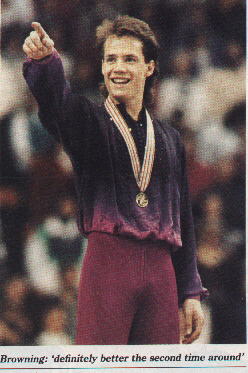|
Back-to-back gold
| Source: |
Maclean's, v103 n12 p46(1). |
| Date: |
March 19, 1990 |
| Author: |
Glen Allen |
Full Text COPYRIGHT Maclean Hunter Ltd. (Canada) 1990
|
In the year since Kurt Browning won the 1989 men's world championships in
Paris, he had often fallen and faltered, making doubters of many admirers.
Even Johnny Esaw, the recently retired CTV sports executive who helped to
bring figure skating into Canadian living rooms nearly 30 years ago, said that
he was not sure that Browning could recapture his gold-medal form. Said Esaw
on the eve of last week's 1990 championships in Halifax: "Browning will either
be red-hot or ice-cold. If he isn't hot, he'll get his ears boxed by the
Russians or the Americans." But the 23-year-old from Caroline, Alta., last
week had clearly regained his incandescent peak. After an electrifying
showdown with Soviet rival Viktor Petrenko in the men's free-skating program
on Thursday before 9,500 enraptured spectators in the city's Metro Centre,
Browning became the first Canadian male skater ever to win back-to-back world
championships. Said a poised and beaming Browning following his unprecedented
victory: "It's definitely better the second time around. I really worked for
this one."
Browning's triumph, which he achieved even without performing his trademark
quadruple jump, was the highlight of a week that brought distinction to other
Canadian skaters as well. Pairs skaters Isabelle Brasseur and Lloyd Eisler
brought their audience to its feet with a stylish freestyle performance that
won them a second-place silver medal on the previous evening. Brasseur, 19,
from St-Jean-sur-Richelieu, Que., and Eisler, 26, from Seaforth, Ont.,
finished in seventh place in Paris last year. But after a sparkling showing,
they triumphed over two of the three favored Soviet pairs teams and were only
narrowly beaten by four-time Soviet champions Ekaterina Gordeeva and Sergei
Grinkov, who won the gold medal at the Calgary Winter Games. |

|
After Browning's championship performance, he said that he had planned to
attempt the same spectacular quadruple jump that helped him to victory in
Paris last year. But he said that when he started the jump, about 15 seconds
into his performance, he could feel that it was not working and turned it into
a triple jump instead. "The quad was planned, but I didn't follow through,"
Browning told reporters. "I'm a little disappointed with myself. But I knew
that a fall or a mistake would make things too close."
In the dance pairs competition, the innovative Canadian sister-and-brother
team of Isabelle and Paul Duchesnays, who left Canada in 1985 to compete for
France, where Paul was born, won a silver medal, after winning the Friday
night long dance program. The Duchesnays, who are noted for their daring
costumes and individualistic technique, won five perfect 6.0 scores for
artistic impression from the nine judges. Marina Klimova and Sergei
Ponomarenko of the Soviet Union won the gold medal. "The crowd was terrific,"
said Paul Duchesnay. "We couldn't have done it without them."
In the women's division, the diminutive but powerful 1989 women's world
champion, Japan's Midori Ito, experienced a major upset, losing the gold medal
to 21-year-old American Jill Trenary. After finishing 10th in the compulsory
figures, which make up 20 per cent of the final mark, Ito, 20, came back to
win both the short and long programs, but it was only good enough for second
place after her disastrous start.
The Halifax championships, watched by tens of millions of people around the
world, were seen as a midterm test for the 1992 Olympics, scheduled for
Albertville, France. Many of the 161 competitors from 27 nations represented a
new and largely untested younger generation of skaters who will be called upon
to replace such stars of the 1980s as Canadians Elizabeth Manley and Brian
Orser, American Brian Boitano and East Germany's Katarina Witt. For some,
including 17-year-old Elvis Stojko, the Richmond Hill, Ont., prodigy who
placed ninth on March 8 in his first world competition, that midterm report
was auspicious indeed. Said Stojko's coach, Douglas Leigh, of Barrie, Ont.,
who also coached Olympic silver medallist Orser: "He's an excellent
technician. He's a skater to be reckoned with."
The city of Halifax, which began preparing for the competition four years ago,
also emerged from the championships as a clear winner. More than 6,000
visitors to the city, from as far away as Japan and Australia, spent $11
million on hotel accommodation, food and other expenses. Organizers said that
revenues from the championships would easily cover the estimated $2.5 million
spent to mount the games and would yield an expected profit of about $1
million for the International Skating Union. While more than two million
Canadians watched the 10 hours of CBC programming of the Halifax event,
millions more overseas tuned into the CBC coverage with voice-over commentary
by personnel from European and Japanese networks. Said Halifax Mayor Ronald
Wallace: "It is the biggest sporting event in our history. You couldn't come
close to buying the promotional value this has."
At the same time, many admirers of figure skating said that competitions like
the Halifax championships help to make the sport more popular. Marion Cassie,
an Uxbridge, Ont., law clerk who took skater-daughters Sandra, 15, and Jill,
13, to the competitions in Halifax, said that the sport's popularity is on the
rise. "For one thing," she said, "there are 160,000 skaters alone in this
country now. And that will grow by thousands more in years to come." For his
part, Esaw said that "for so long, we took figure skating for granted. But it
is a natural - the most telegenic of all sports. You have one kid at centre
ice, four or five cameras, beauty, talent and the best music in the world." As
the Halifax championships demonstrated, a pastime that once was relegated to
newspaper social pages is cutting an ever-larger figure on the international
sporting scene.
|

